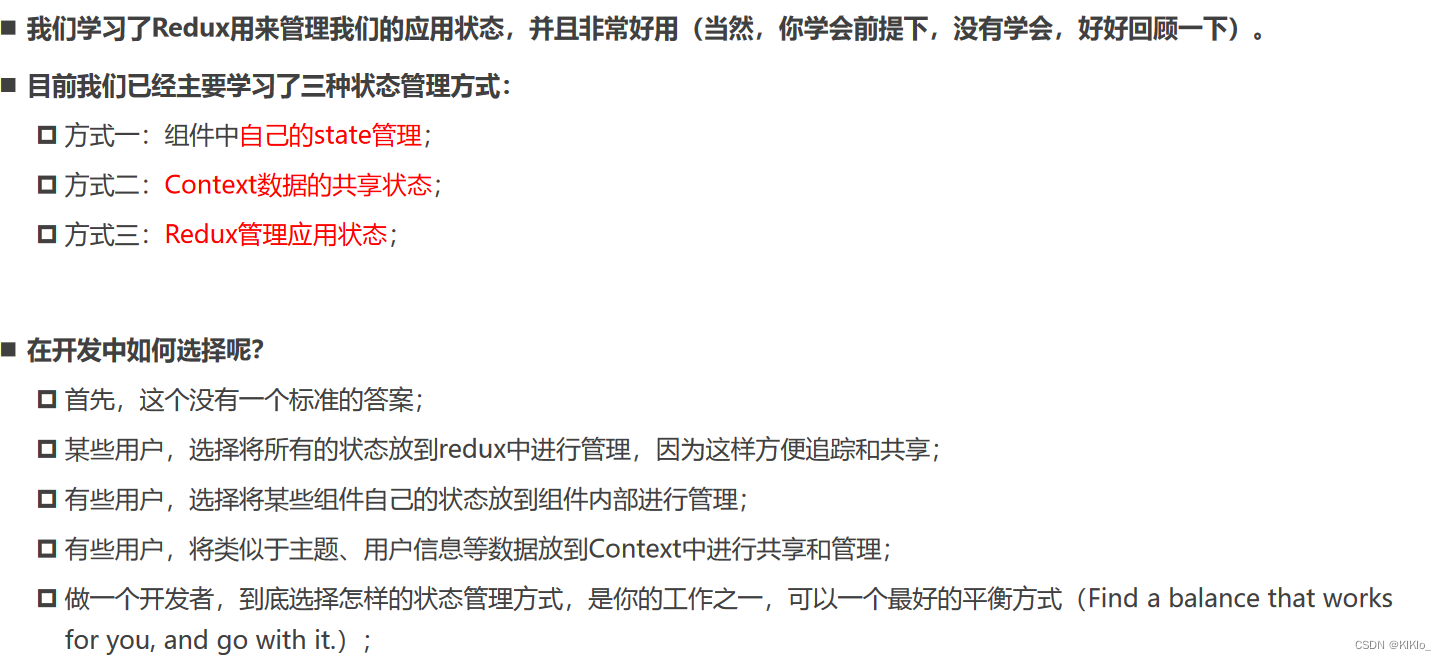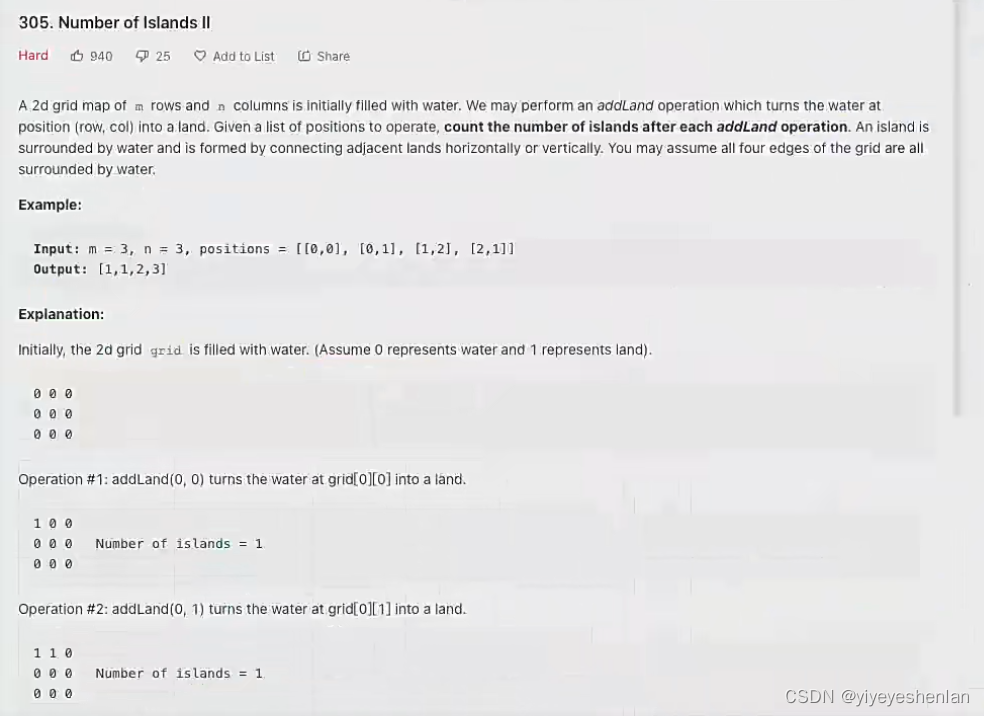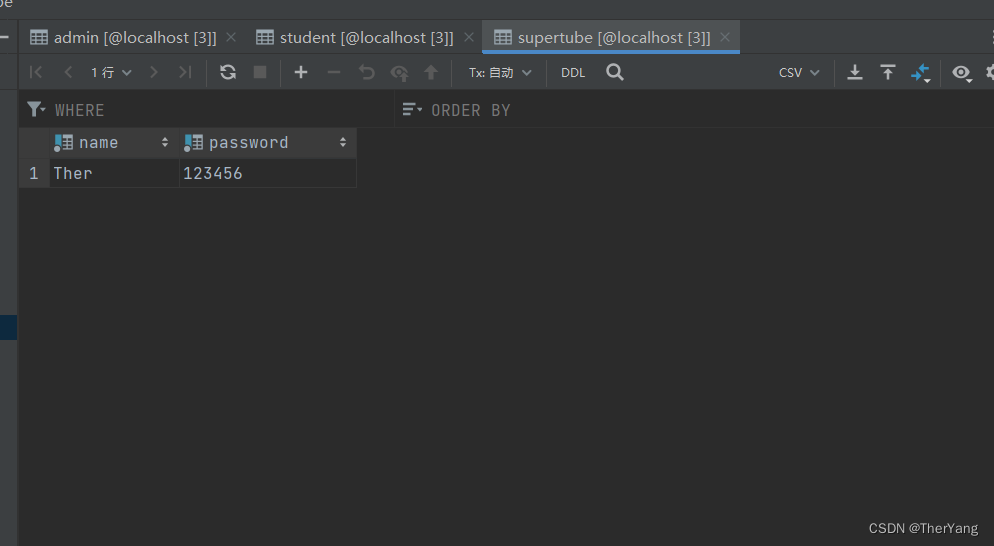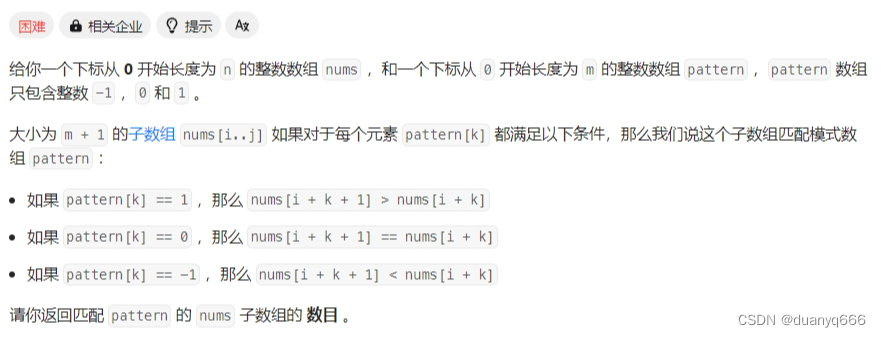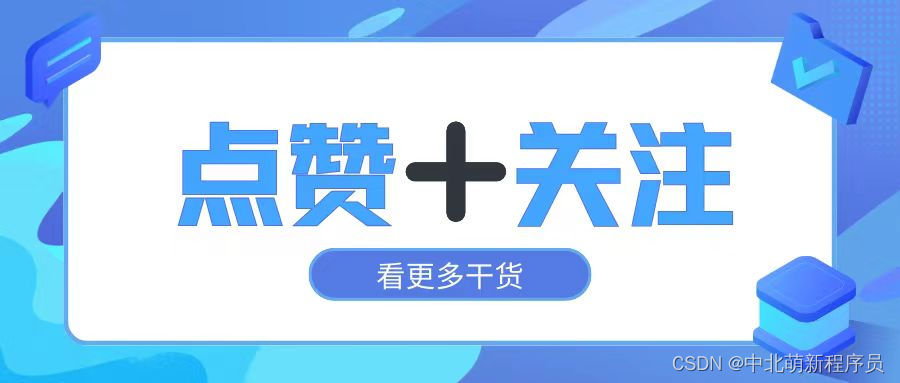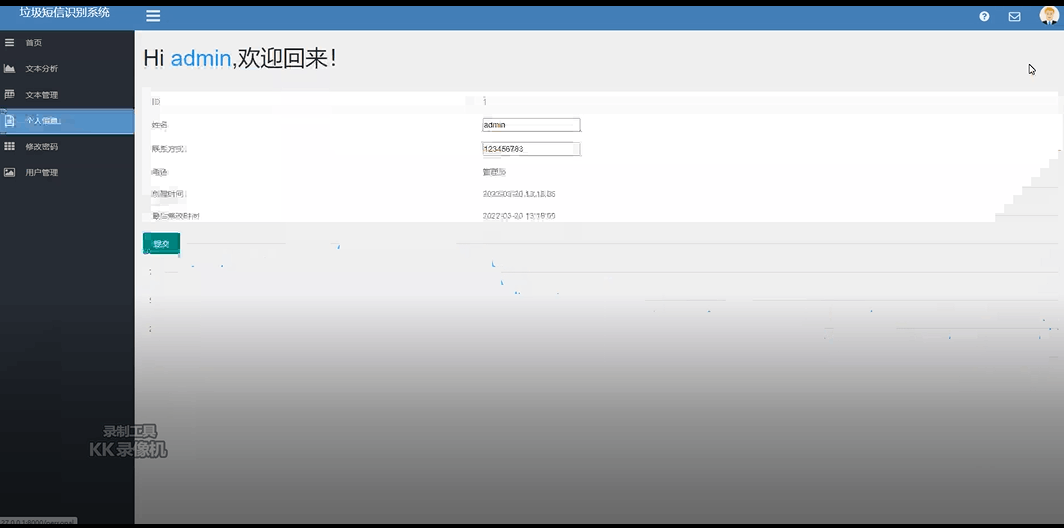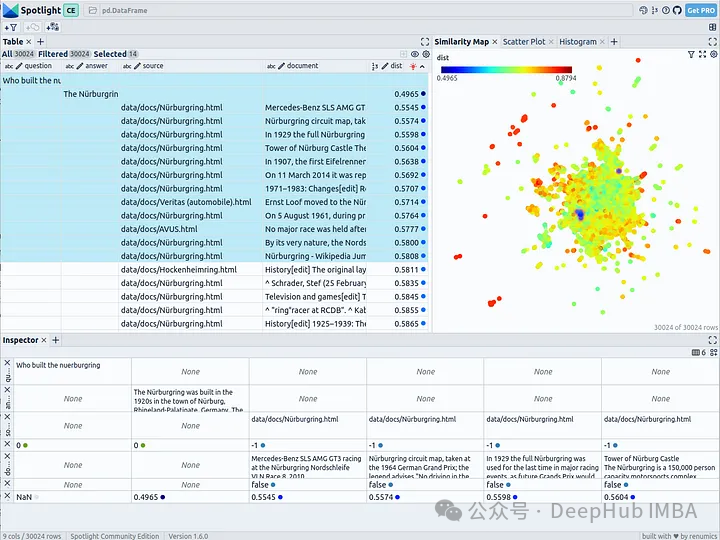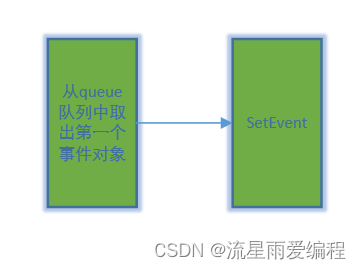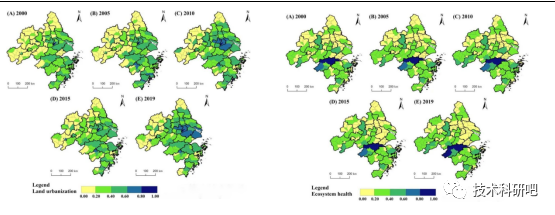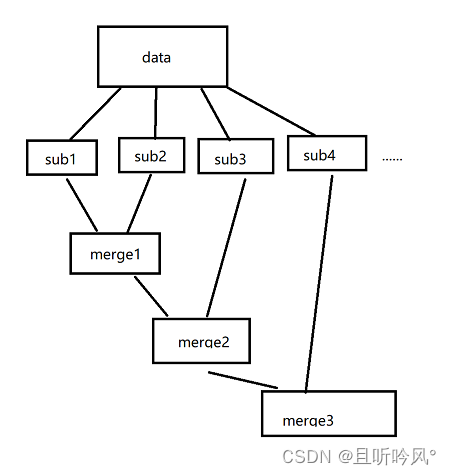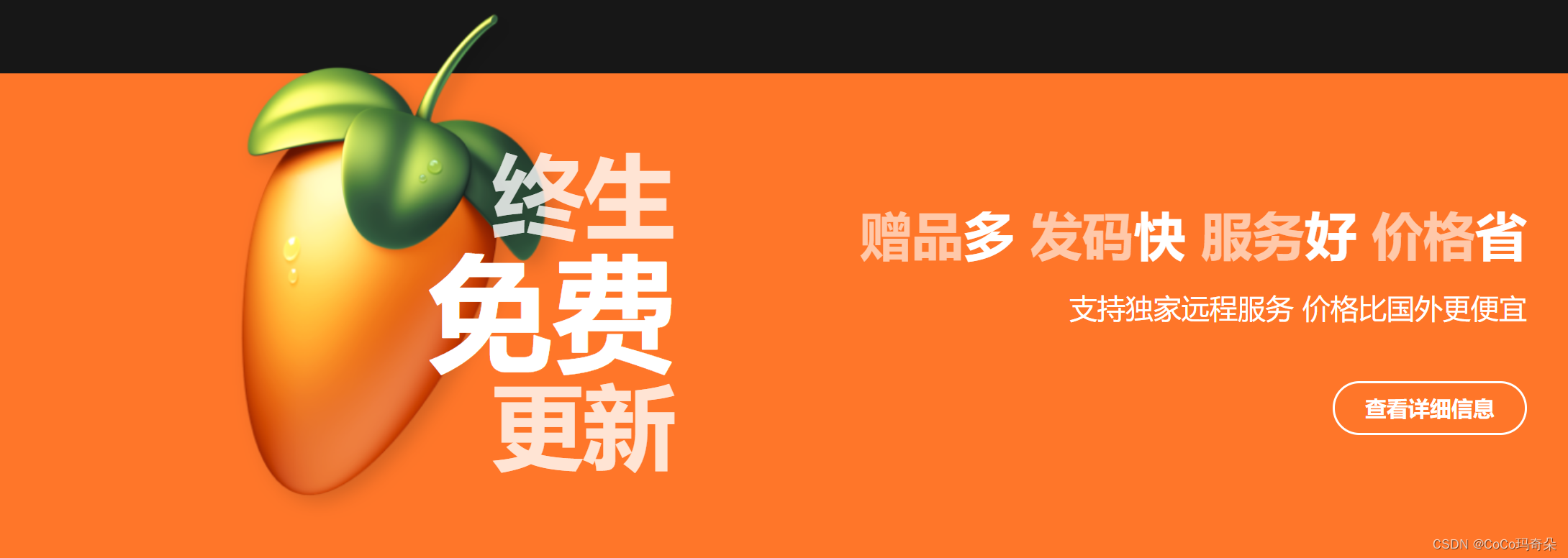文章目录
- 1、回顾纯函数
- 2、redux
- 2.1 redux的基本使用
- 2.2 通过action修改store的数值
- 2.3 订阅state的变化
- 2.4 目录结构
- 2.5 Redux的使用过程
- 2.6 redux的三大原则
- 2.7 Redux官方图
- 3、redux在React中的使用
- 4、react-redux使用
- 4.1 react-redux的基本使用
- 4.2 异步请求 redux-thunk
- 4.3 对redux代码结构进行优化 和 redux-devtools
- 5、ReduxToolkit
- 5.1 基本使用
- 5.2 异步操作 写法1
- 5.3 异步操作 写法2
- 6、手写connext
- 7、合并中间件
- 8、React中的state如何管理
1、回顾纯函数

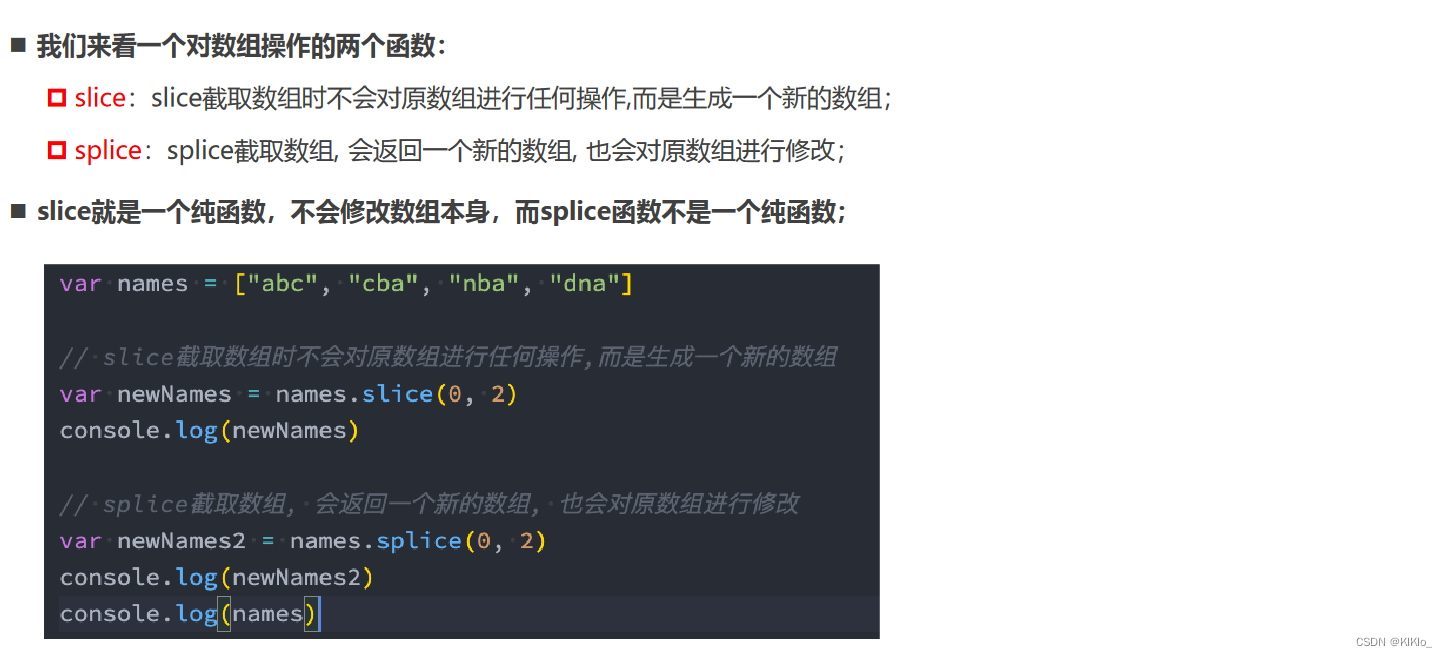

2、redux
2.1 redux的基本使用
pm install redux --save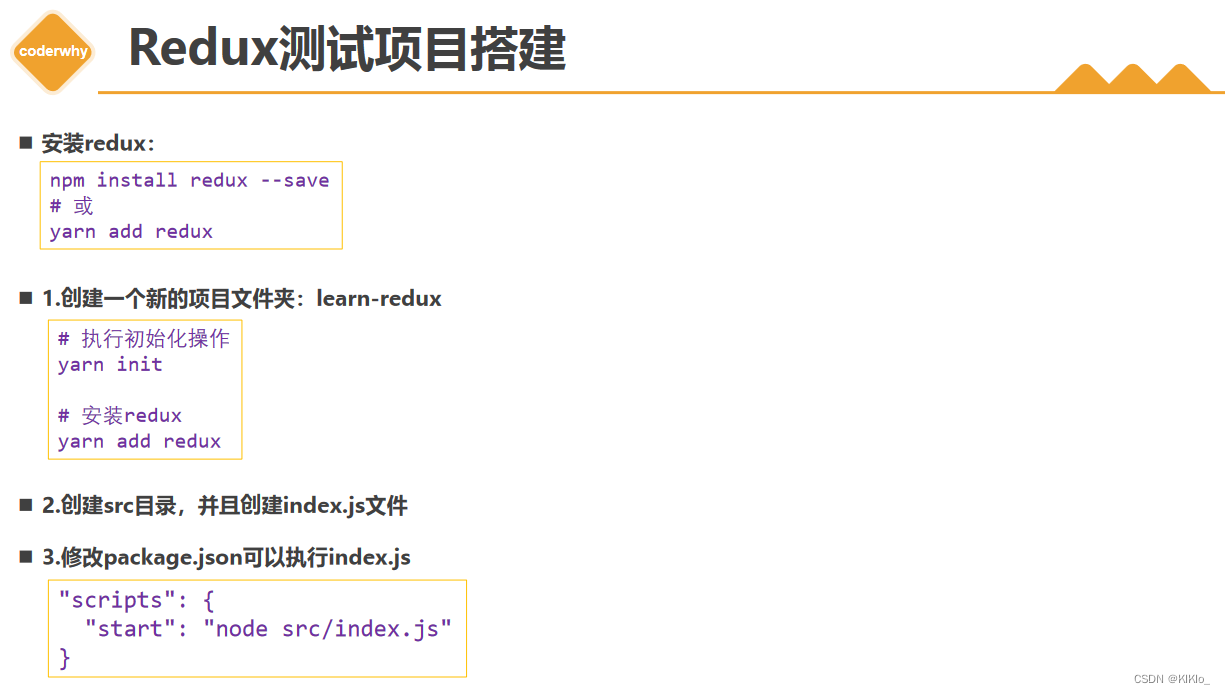
- store
const { createStore } = require("redux");
// 1.state数据
const initialState = {
name: "kiki",
age: "18",
};
// 2.reducer纯函数
function reducer() {
return initialState;
}
// 3.创建store
const store = createStore(reducer);
module.exports = store;
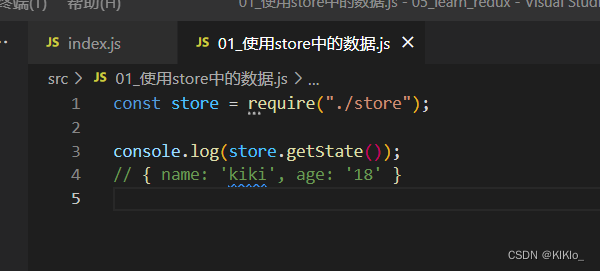
2.2 通过action修改store的数值
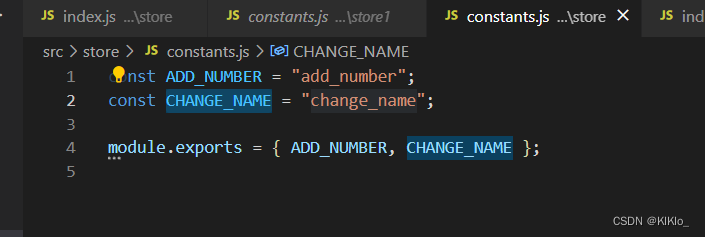
const { createStore } = require("redux");
const { ADD_NUMBER, CHANGE_NAME } = require("./constants");
// 1.state数据
const initialState = {
name: "kiki",
num: 18,
};
// 2.reducer纯函数
// 两个参数
// 参数1:store目前保存的state 设置默认参数
// 参数2:本次需要更新的action
// 返回值 他的返回值作为之后存储在store的数值 因为第一次调用没有数值 所以设置默认值
function reducer(state = initialState, action) {
console.log(state, action); // { name: 'kiki', num: '18' } { type: '@@redux/INIT0.n.r.y.w.j' }
switch (action.type) {
case ADD_NUMBER:
// 这里需要创建新的对象的返回 否则页面发现state没有发生变化不会更新界面
return { ...state, num: state.num + action.num };
case CHANGE_NAME:
return { ...state, name: action.name };
default:
return state;
}
}
// 3.创建store
const store = createStore(reducer);
module.exports = store;
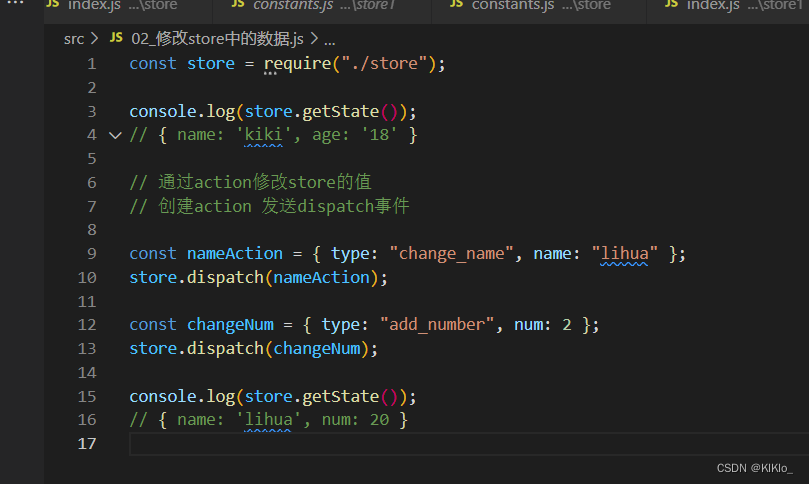
2.3 订阅state的变化
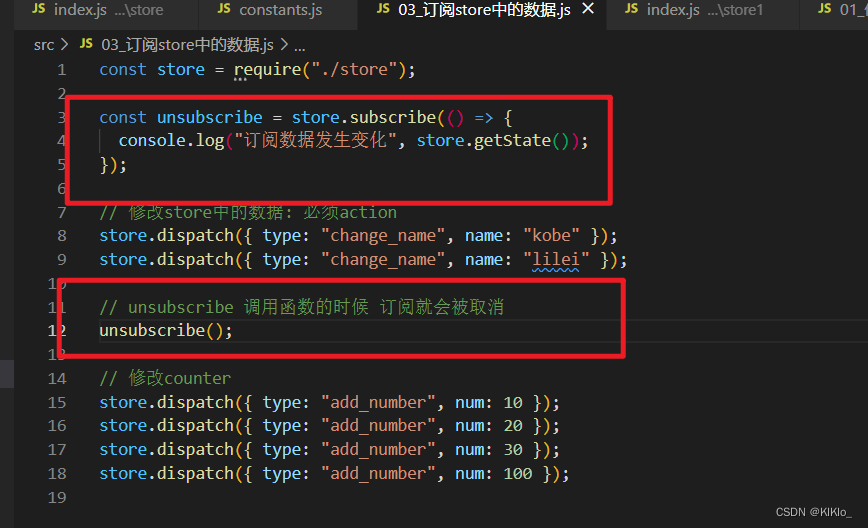
2.4 目录结构

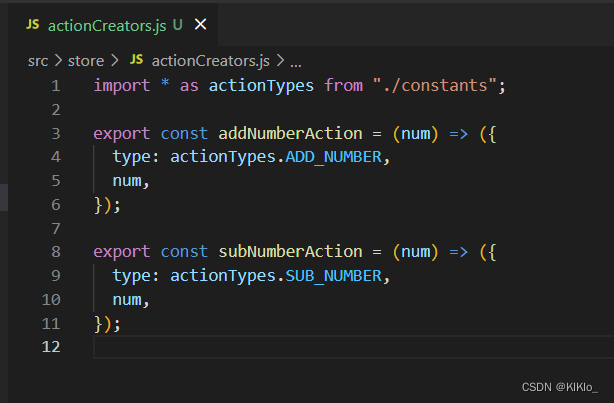
2.5 Redux的使用过程
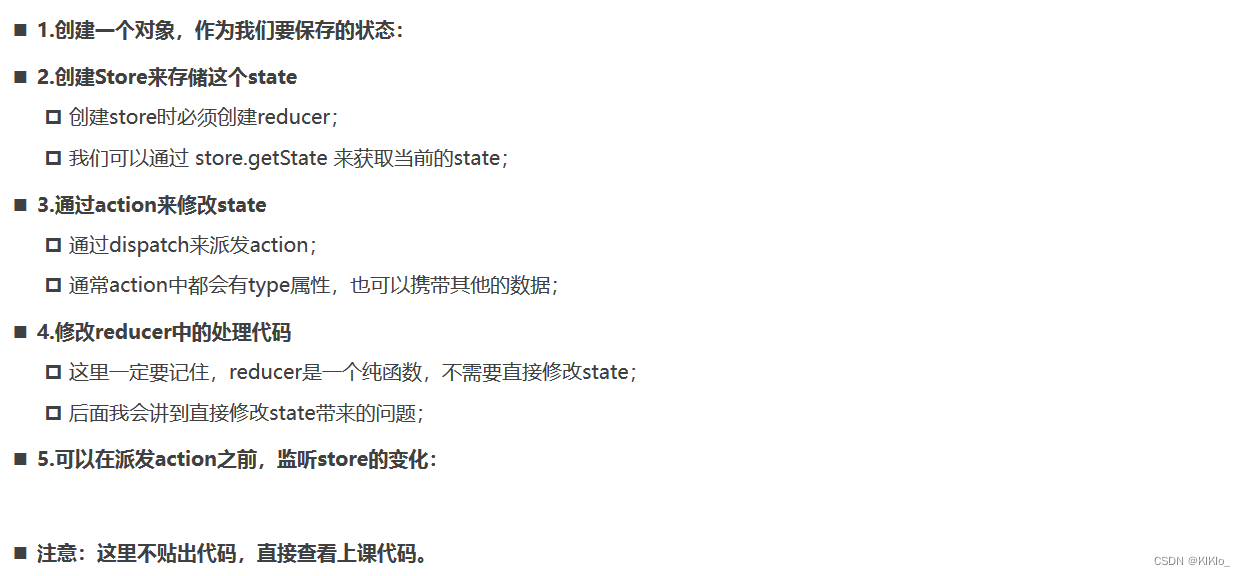
2.6 redux的三大原则
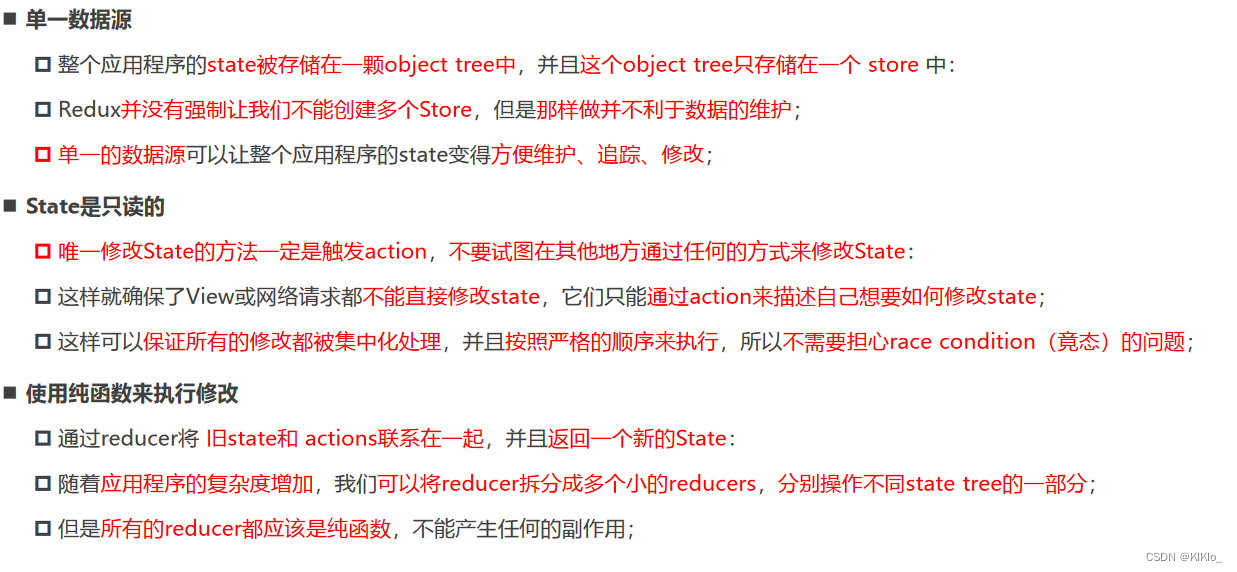
2.7 Redux官方图
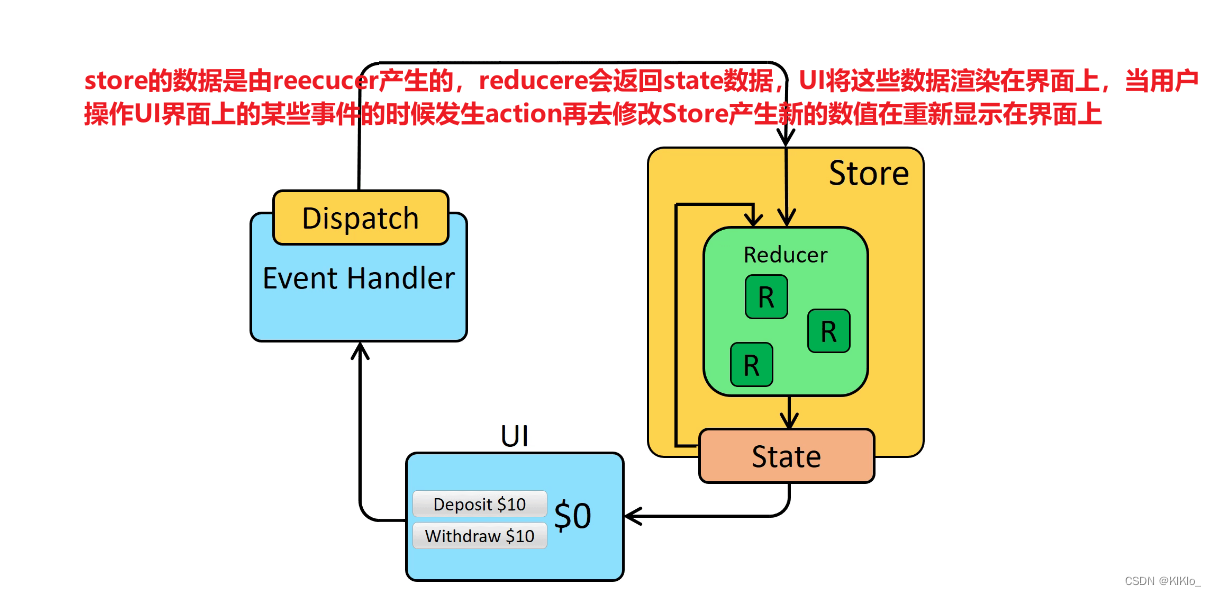
3、redux在React中的使用
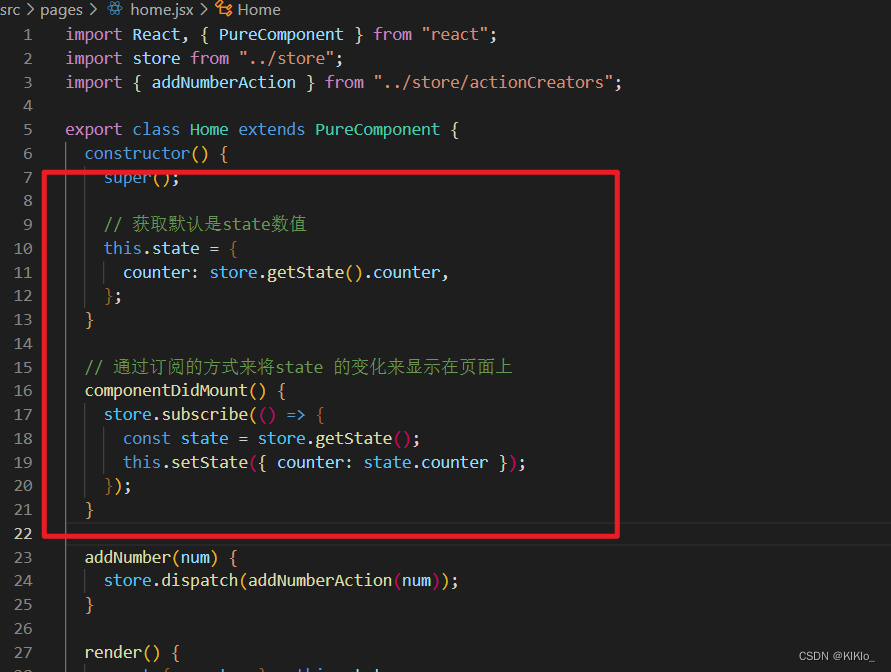
4、react-redux使用
yarn add react-redux
4.1 react-redux的基本使用

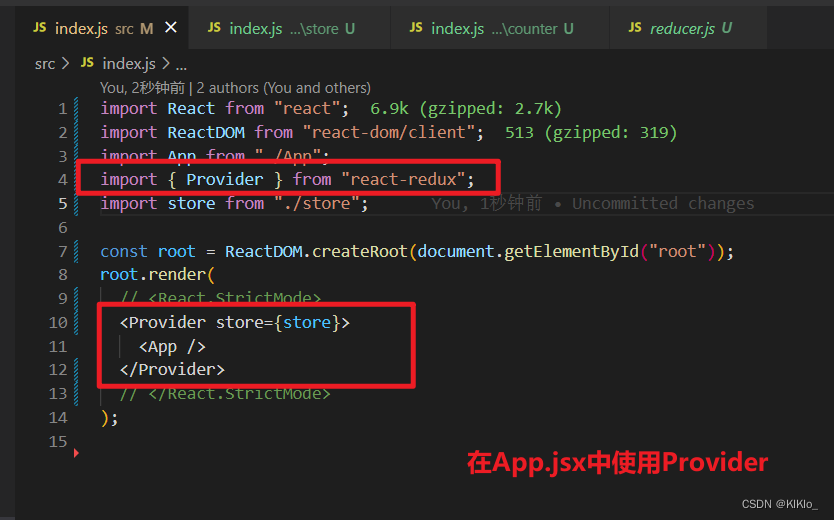
import React, { PureComponent } from "react";
import { connect } from "react-redux";
// import store from "../store"
import { addNumberAction, subNumberAction } from "../store/actionCreators";
export class About extends PureComponent {
calcNumber(num, isAdd) {
if (isAdd) {
console.log("加", num);
this.props.addNumber(num);
} else {
console.log("减", num);
this.props.subNumber(num);
}
}
render() {
const { counter, banners, recommends } = this.props;
return (
<div>
<h2>About Page: {counter}</h2>
<div>
<button onClick={(e) => this.calcNumber(6, true)}>+6</button>
<button onClick={(e) => this.calcNumber(88, true)}>+88</button>
<button onClick={(e) => this.calcNumber(6, false)}>-6</button>
<button onClick={(e) => this.calcNumber(88, false)}>-88</button>
</div>
</div>
);
}
}
// connect()返回值是一个高阶组件
// function mapStateToProps(state) {
// return {
// counter: state.counter
// }
// }
// function fn2(dispatch) {
// return {
// addNumber(num) {
// dispatch(addNumberAction(num))
// },
// subNumber(num) {
// dispatch(subNumberAction(num))
// }
// }
// }
const mapStateToProps = (state) => ({
counter: state.counter,
banners: state.banners,
recommends: state.recommends,
});
const mapDispatchToProps = (dispatch) => ({
addNumber(num) {
dispatch(addNumberAction(num));
},
subNumber(num) {
dispatch(subNumberAction(num));
},
});
// connect是高阶组件
export default connect(mapStateToProps, mapDispatchToProps)(About);
4.2 异步请求 redux-thunk
yarn add redux-thunk
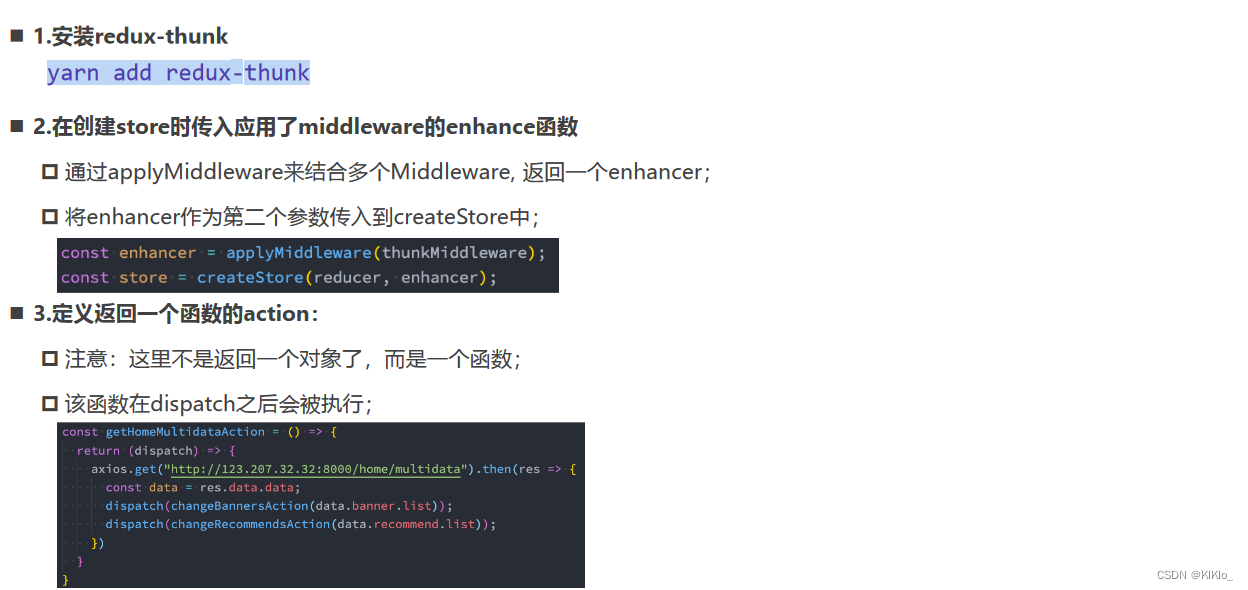
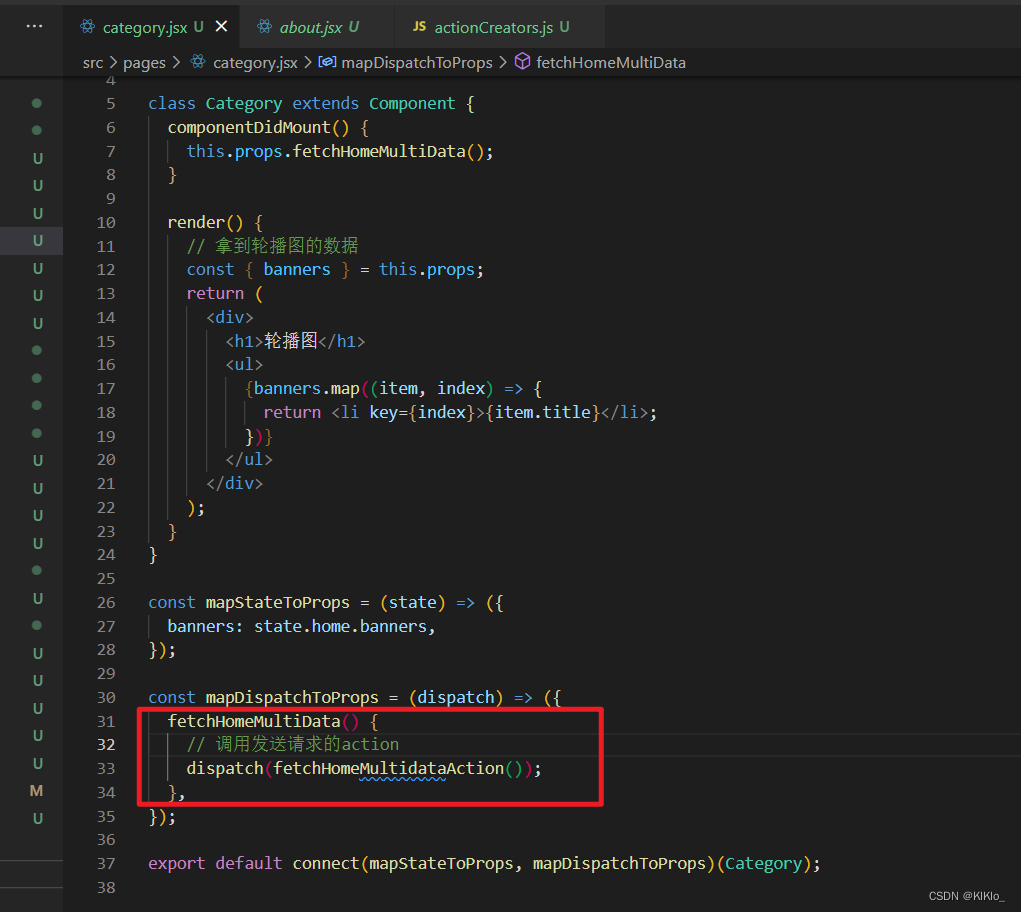
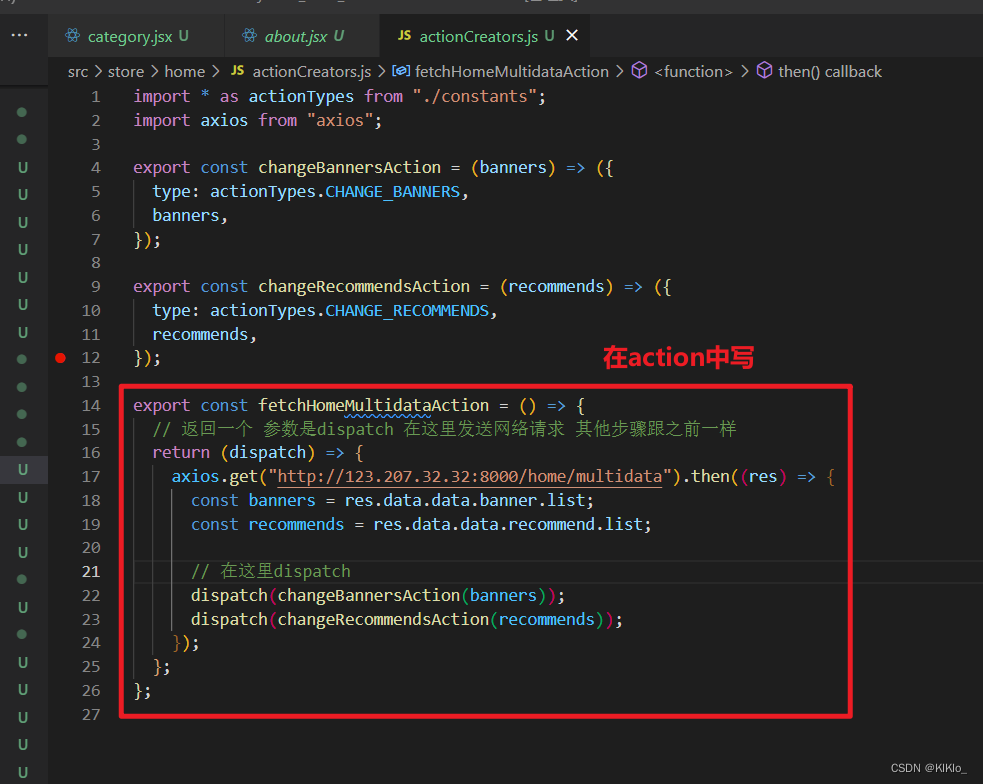
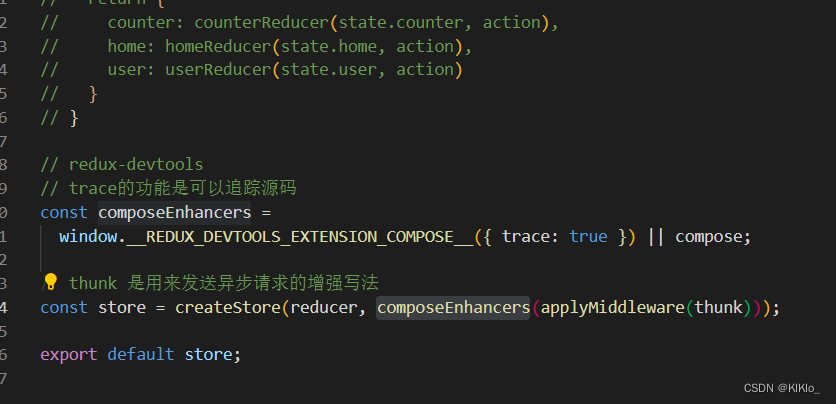
4.3 对redux代码结构进行优化 和 redux-devtools
每个页面可能都会有自己的store为了方便维护,将store按照页面划分
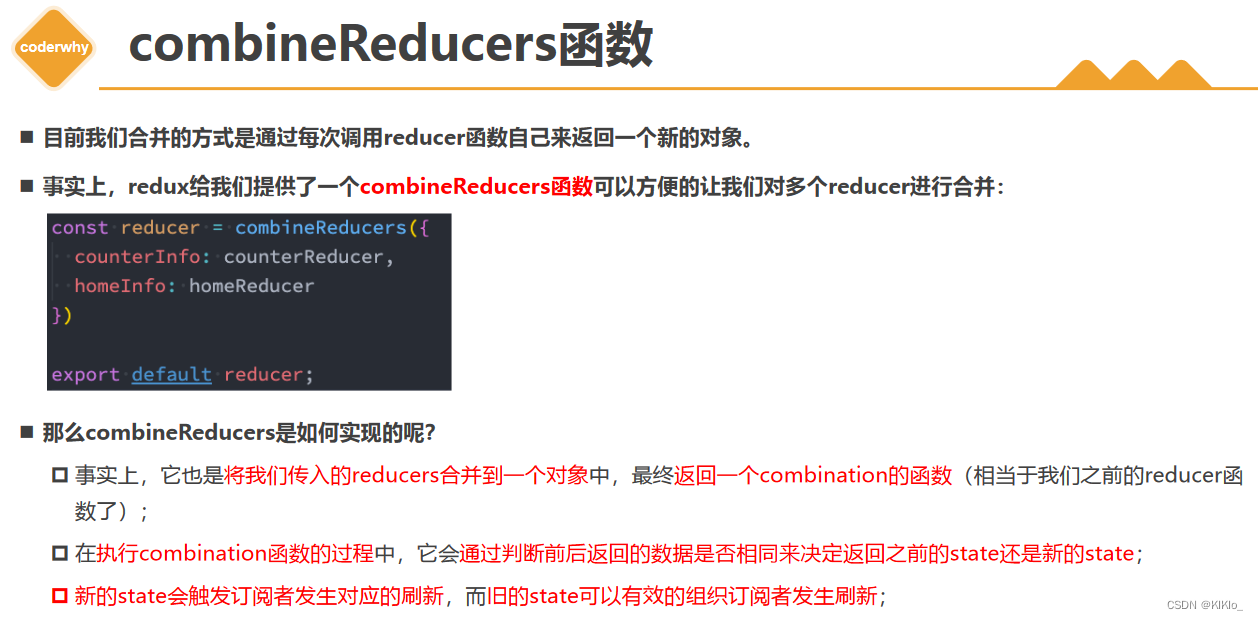

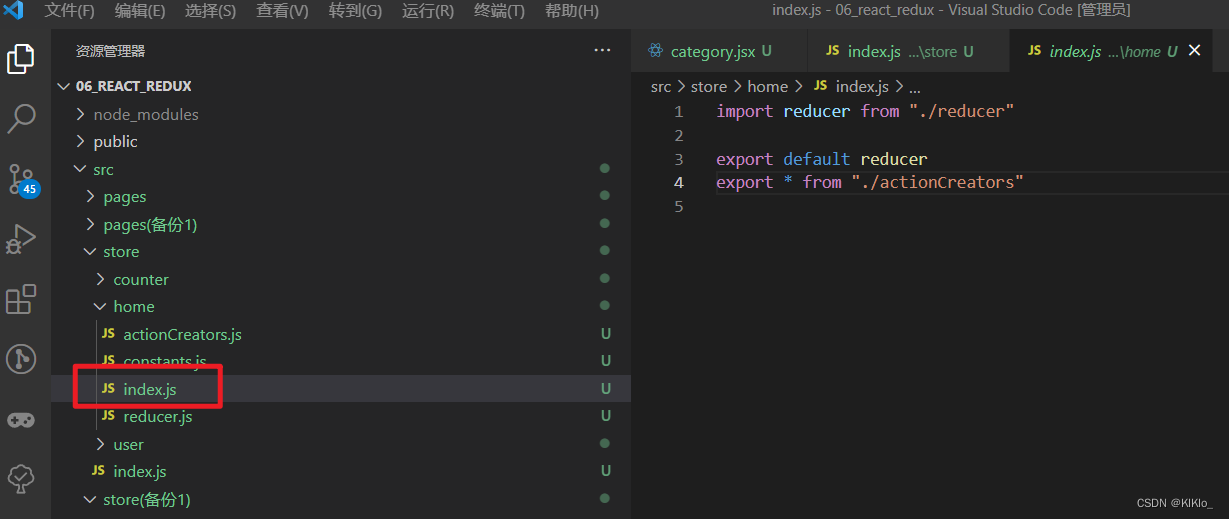
import { createStore, applyMiddleware, compose, combineReducers } from "redux";
import thunk from "redux-thunk";
import counterReducer from "./counter";
import homeReducer from "./home";
import userReducer from "./user";
// 正常情况下 store.dispatch(object)
// 想要派发函数 store.dispatch(function)
// 将两个reducer合并在一起
const reducer = combineReducers({
counter: counterReducer,
home: homeReducer,
user: userReducer,
});
// combineReducers实现原理(了解)
// function reducer(state = {}, action) {
// // 返回一个对象, store的state
// return {
// counter: counterReducer(state.counter, action),
// home: homeReducer(state.home, action),
// user: userReducer(state.user, action)
// }
// }
// redux-devtools
// trace的功能是可以追踪源码
const composeEnhancers =
window.__REDUX_DEVTOOLS_EXTENSION_COMPOSE__({ trace: true }) || compose;
// thunk 是用来发送异步请求的增强写法
const store = createStore(reducer, composeEnhancers(applyMiddleware(thunk)));
export default store;

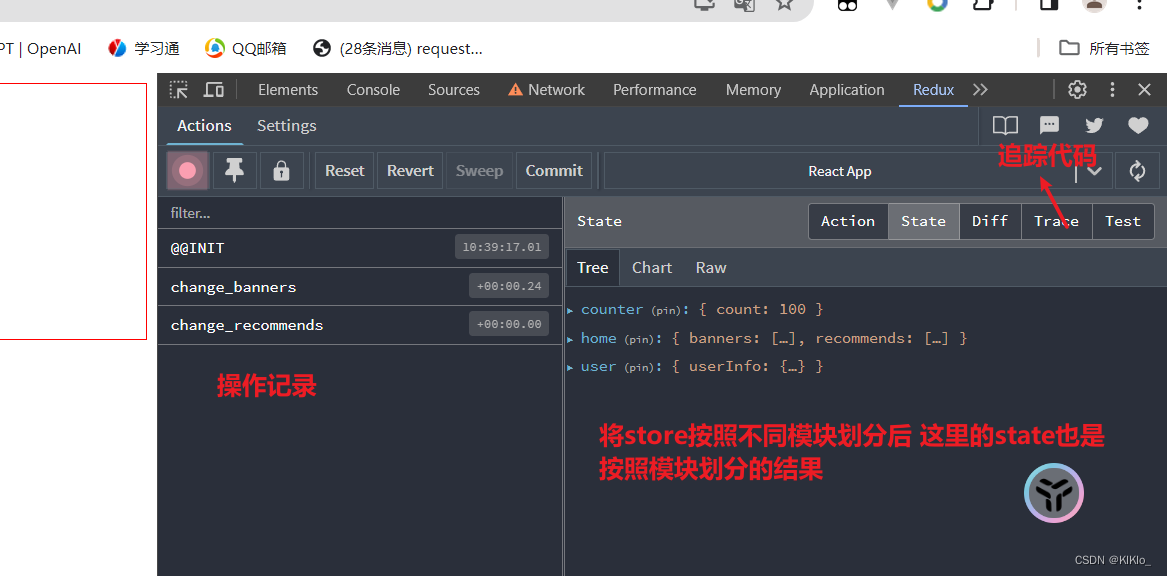
5、ReduxToolkit
5.1 基本使用
npm install @reduxjs/toolkit react-redux
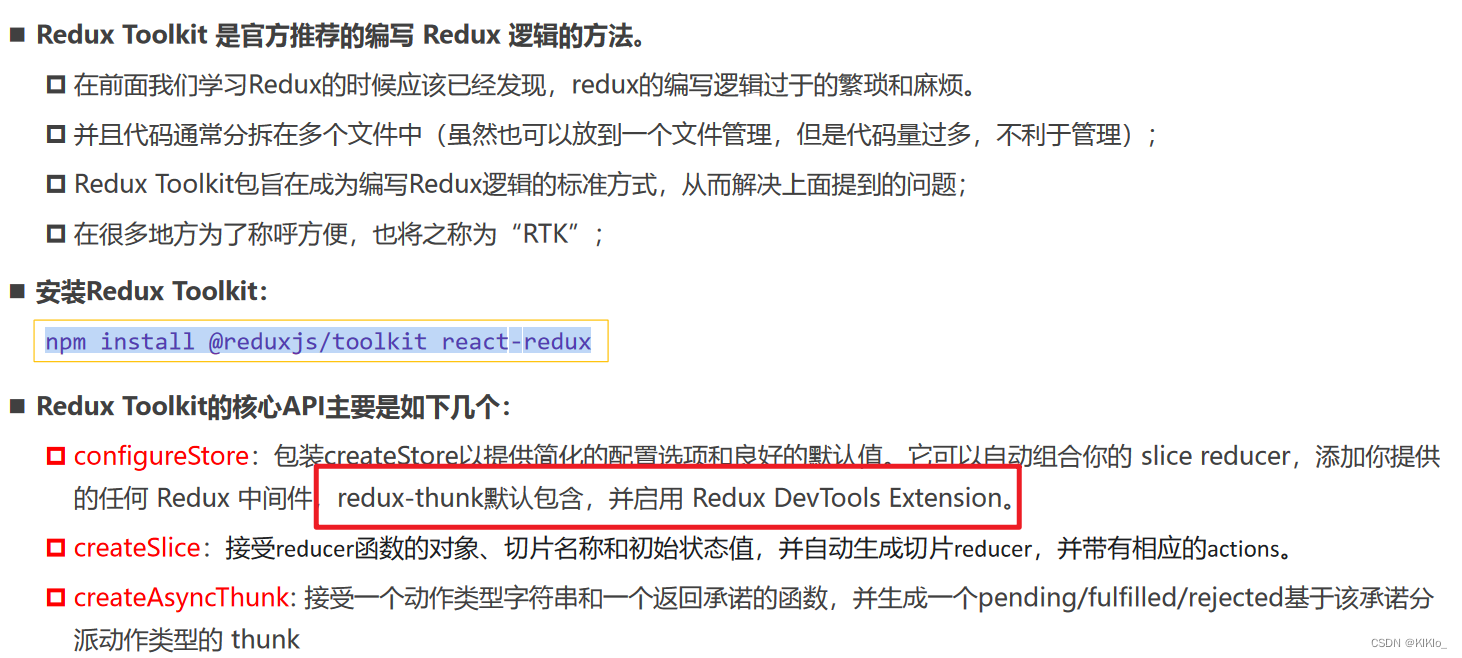
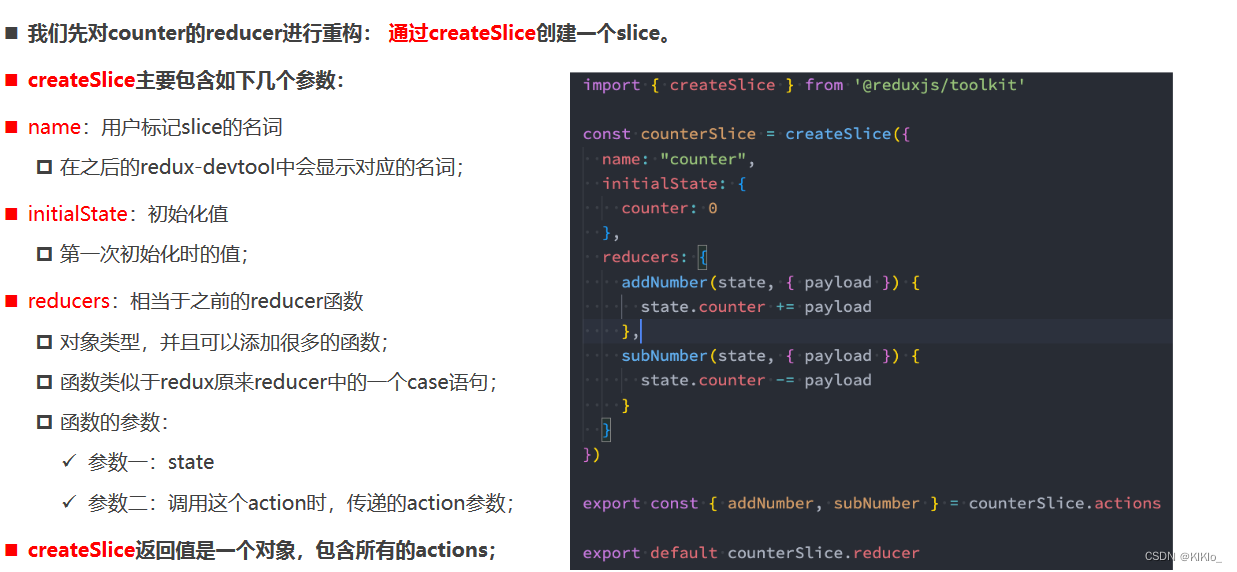
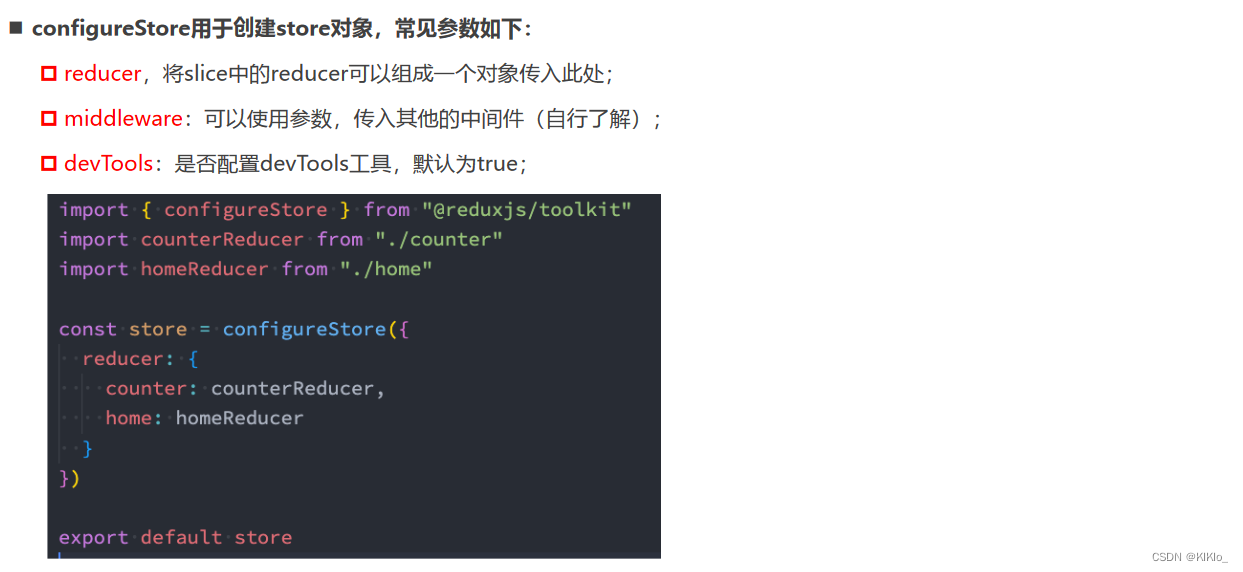
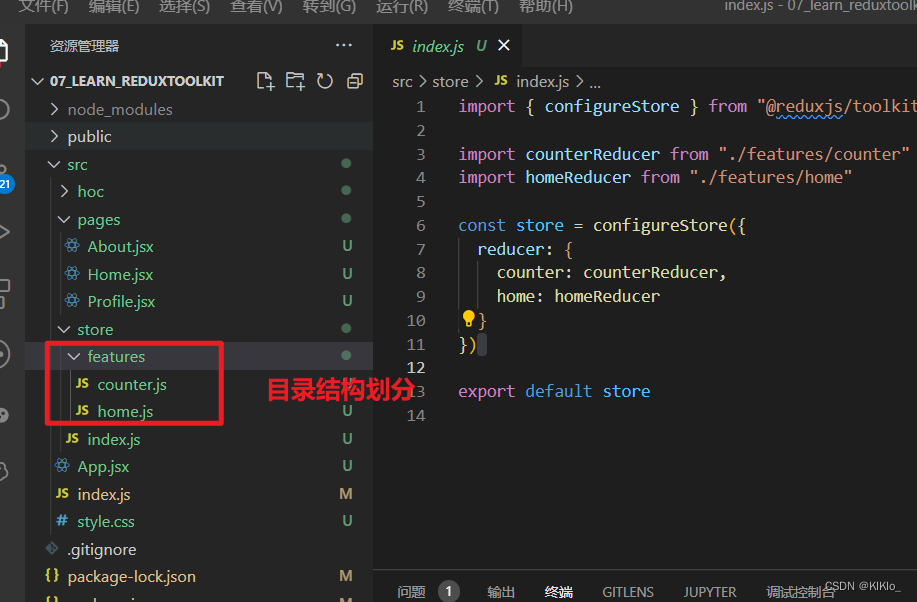
- 需要在根组件传递store的值

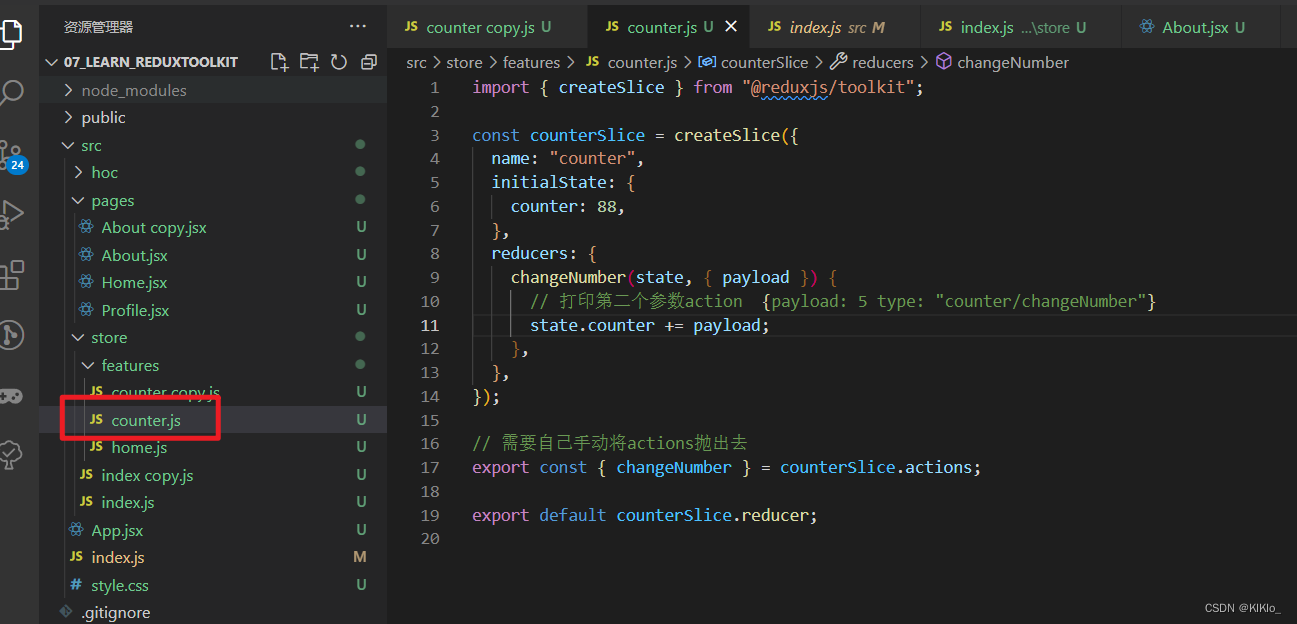
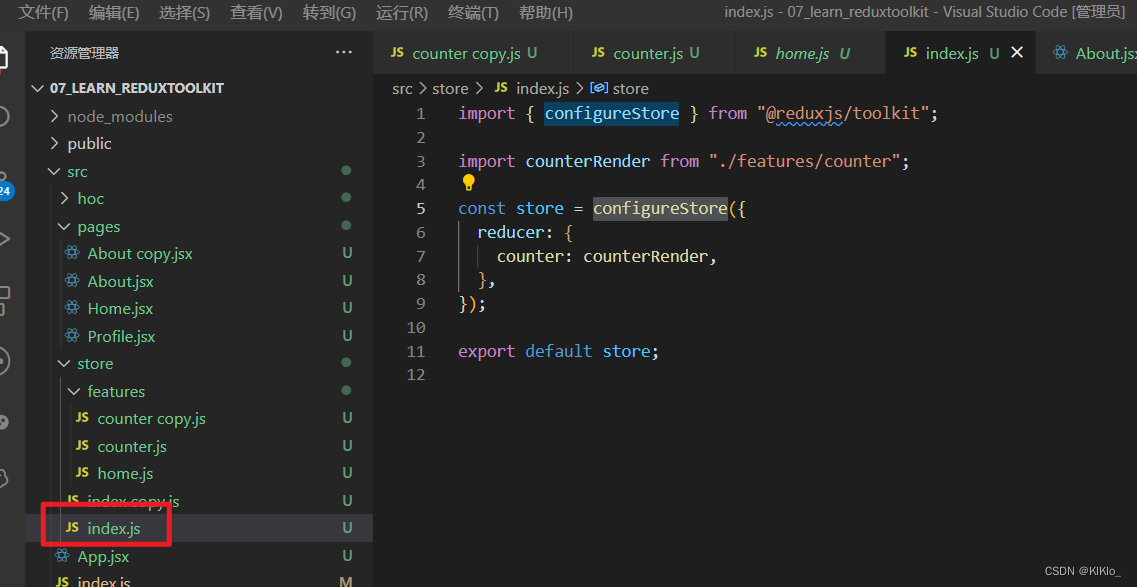
import React, { PureComponent } from "react";
import { connect } from "react-redux";
import { changeNumber } from "../store/features/counter";
export class About extends PureComponent {
changeNum(num) {
this.props.changeNumber(num);
}
render() {
const { counter } = this.props;
return (
<div>
{counter}
<button onClick={(e) => this.changeNum(5)}>+5</button>
</div>
);
}
}
const mapStateToProps = (state) => ({
counter: state.counter.counter,
});
const mapDispatchToProps = (dispatch) => ({
changeNumber(num) {
dispatch(changeNumber(num));
},
});
export default connect(mapStateToProps, mapDispatchToProps)(About);
5.2 异步操作 写法1
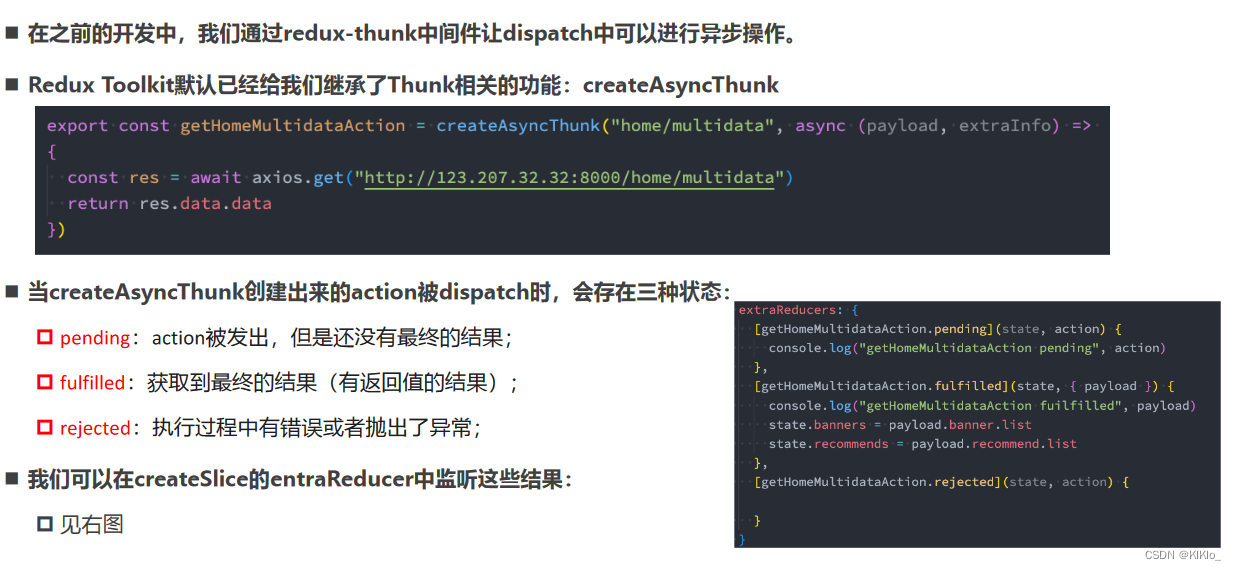
import { createAsyncThunk } from "@reduxjs/toolkit";
import { createSlice } from "@reduxjs/toolkit";
import axios from "axios";
// toolkit已经集成了thunk所以可以直接使用
// 第一个参数是name可以根据自己的喜好取
// 可以把这个函数看成是promise 它跟promise十分相似
export const fetchHomeMultidataAction = createAsyncThunk(
"fetch/homemultidata",
// dispatch传递的参数是第一个 extraInfo
async (extraInfo, { dispatch, getState }) => {
console.log(extraInfo);
const res = await axios.get("http://123.207.32.32:8000/home/multidata");
// 不能直接返回res 没办法直接对其进行序列化
return res.data;
}
);
const homeSlice = createSlice({
name: "home",
initialState: {
banner: [],
},
reducers: {
changeBanner(state, { payload }) {
state.banner = payload;
},
},
// 这里是对异步操作进行操作的方法
extraReducers: {
[fetchHomeMultidataAction.pending](state, action) {
console.log(action);
},
[fetchHomeMultidataAction.fulfilled](state, { payload, meta }) {
// 异步操作返回的参数
state.banner = payload.data.banner.list;
// 在dispatch时传递的参数
console.log(meta.arg);
},
[fetchHomeMultidataAction.rejected](state, action) {
console.log("fetchHomeMultidataAction rejected");
},
},
});
export const { changeBanner } = homeSlice.actions;
export default homeSlice.reducer;
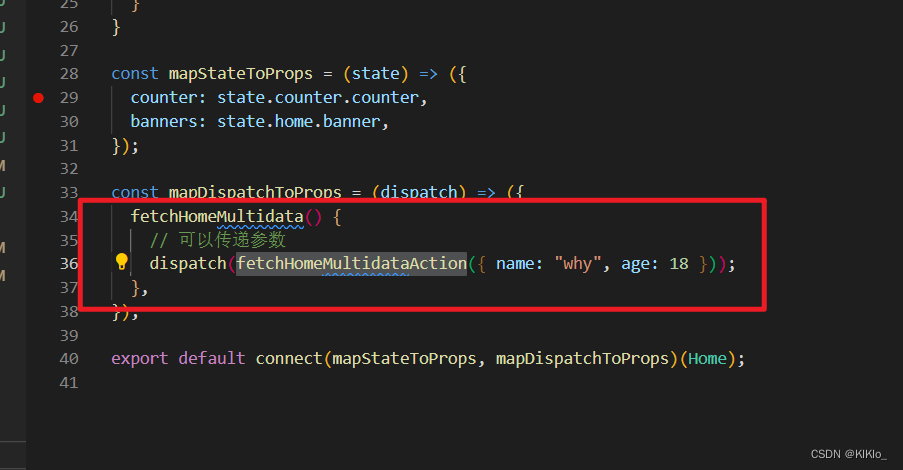
5.3 异步操作 写法2
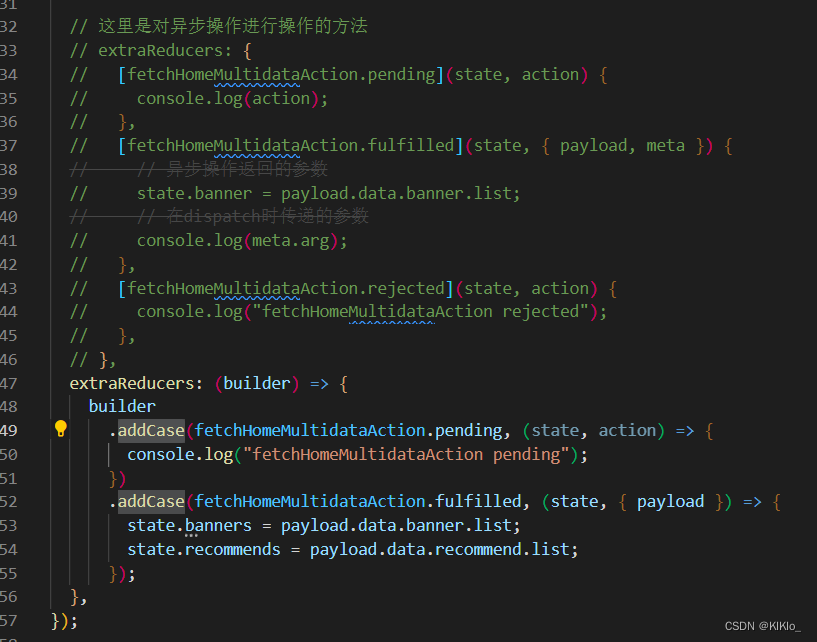
import { createAsyncThunk } from "@reduxjs/toolkit";
import { createSlice } from "@reduxjs/toolkit";
import axios from "axios";
// toolkit已经集成了thunk所以可以直接使用
// 第一个参数是name可以根据自己的喜好取
// 可以把这个函数看成是promise 它跟promise十分相似
export const fetchHomeMultidataAction = createAsyncThunk(
"fetch/homemultidata",
// dispatch传递的参数是第一个 extraInfo
async (extraInfo, { dispatch, getState }) => {
console.log(extraInfo);
const res = await axios.get("http://123.207.32.32:8000/home/multidata");
// 不能直接返回res 没办法直接对其进行序列化
return res.data;
}
);
const homeSlice = createSlice({
name: "home",
initialState: {
banner: [],
},
reducers: {
changeBanner(state, { payload }) {
state.banner = payload;
},
},
// 这里是对异步操作进行操作的方法
// extraReducers: {
// [fetchHomeMultidataAction.pending](state, action) {
// console.log(action);
// },
// [fetchHomeMultidataAction.fulfilled](state, { payload, meta }) {
// // 异步操作返回的参数
// state.banner = payload.data.banner.list;
// // 在dispatch时传递的参数
// console.log(meta.arg);
// },
// [fetchHomeMultidataAction.rejected](state, action) {
// console.log("fetchHomeMultidataAction rejected");
// },
// },
extraReducers: (builder) => {
builder
.addCase(fetchHomeMultidataAction.pending, (state, action) => {
console.log("fetchHomeMultidataAction pending");
})
.addCase(fetchHomeMultidataAction.fulfilled, (state, { payload }) => {
state.banners = payload.data.banner.list;
state.recommends = payload.data.recommend.list;
});
},
});
export const { changeBanner } = homeSlice.actions;
export default homeSlice.reducer;
6、手写connext
// connect的参数:
// 参数一: 函数
// 参数二: 函数
// 返回值: 函数 => 高阶组件
import { PureComponent } from "react";
import { StoreContext } from "./StoreContext";
// import store from "../store"
// 实际上就是一个高阶函数里面嵌套一个高阶组件
export function connect(mapStateToProps, mapDispatchToProps, store) {
// 高阶组件: 函数
return function (WrapperComponent) {
class NewComponent extends PureComponent {
// 接收的第二个参数就是context
constructor(props, context) {
super(props);
this.state = mapStateToProps(context.getState());
}
componentDidMount() {
// 因为页面发生改变是connect自己内部实现的 我们自己手写的话 要手动调用
this.unsubscribe = this.context.subscribe(() => {
// 不能直接通过强制刷新 不然性能很低
// this.forceUpdate()
// 执行ToProps的方法 自己判断是否state发生了变化
this.setState(mapStateToProps(this.context.getState()));
});
}
componentWillUnmount() {
this.unsubscribe();
}
render() {
// 传递进来的两个方法进行调用 再把他们的数值传递给组件 实现了高阶组件的增强
const stateObj = mapStateToProps(this.context.getState());
const dispatchObj = mapDispatchToProps(this.context.dispatch);
return (
<WrapperComponent {...this.props} {...stateObj} {...dispatchObj} />
);
}
}
// 为了避免每次store都是需要传入进来 所以创建了一个context 在注册应用的时候就将他导入
NewComponent.contextType = StoreContext;
return NewComponent;
};
}

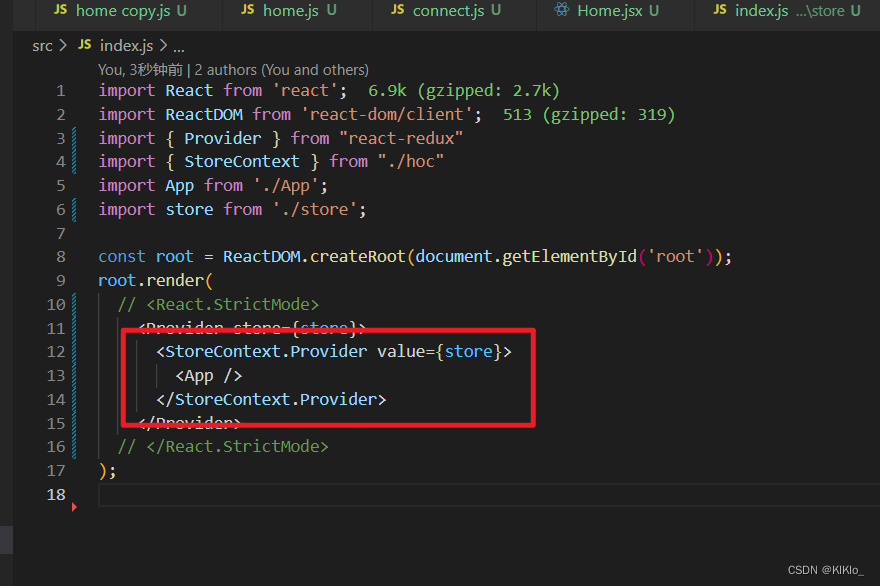
7、合并中间件
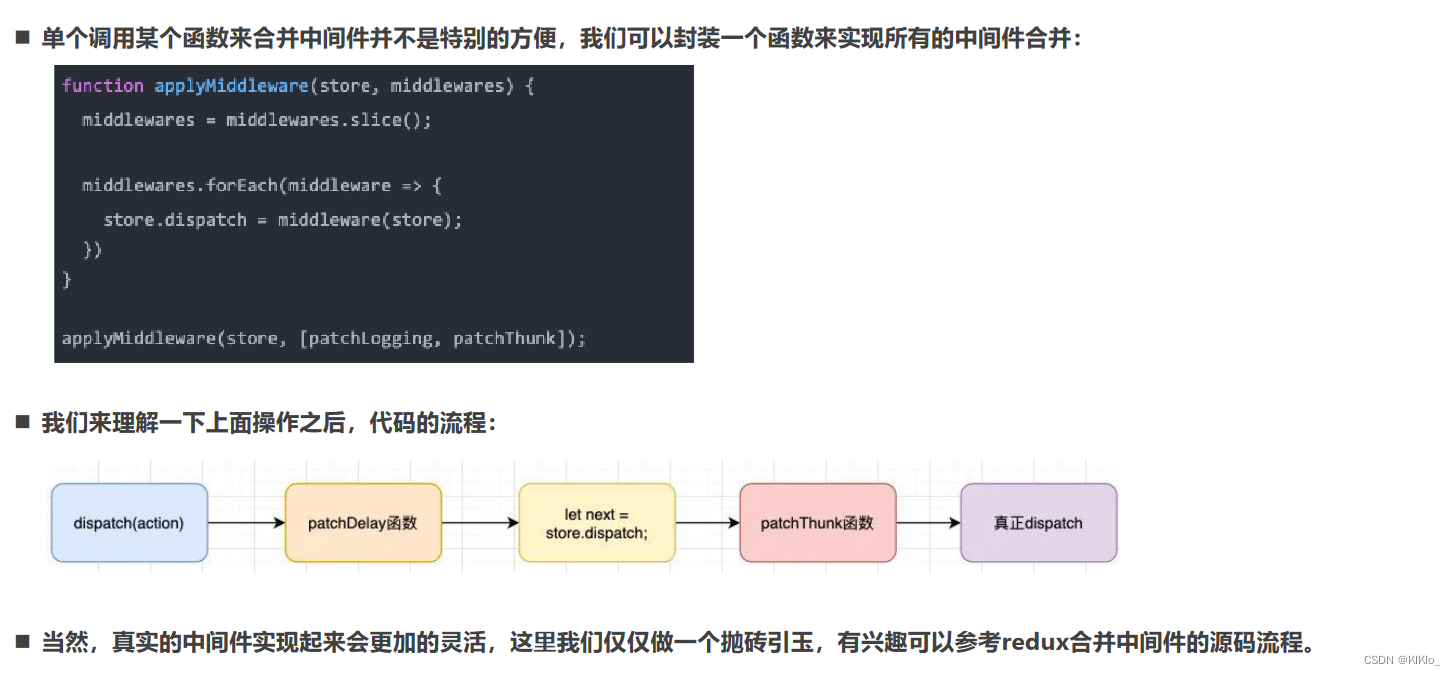
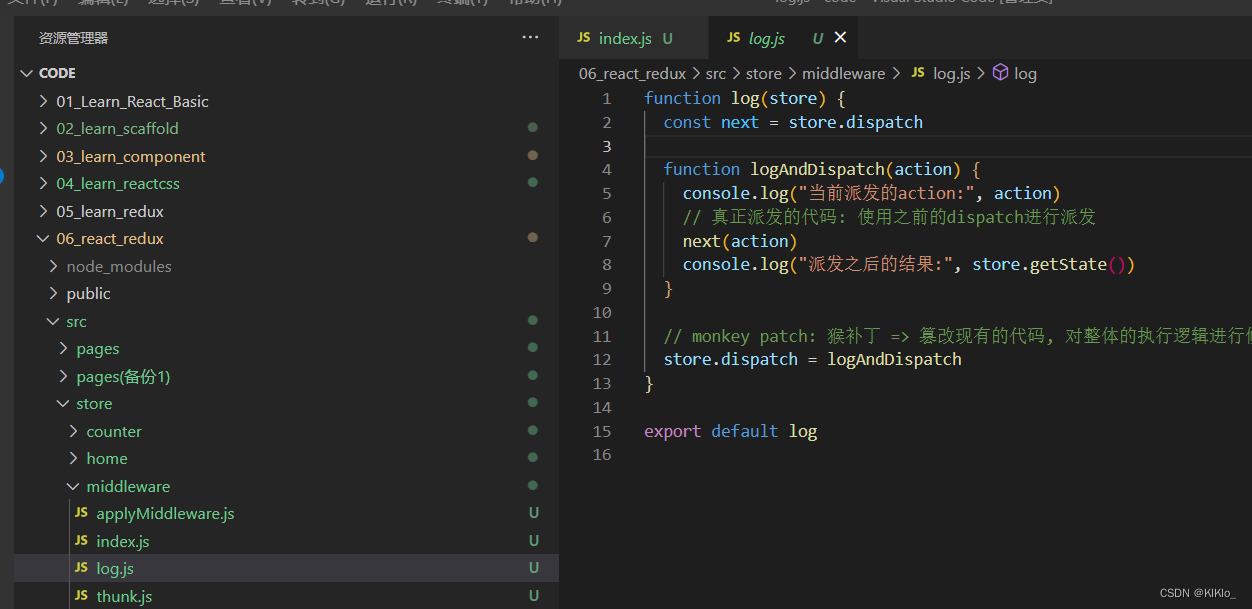
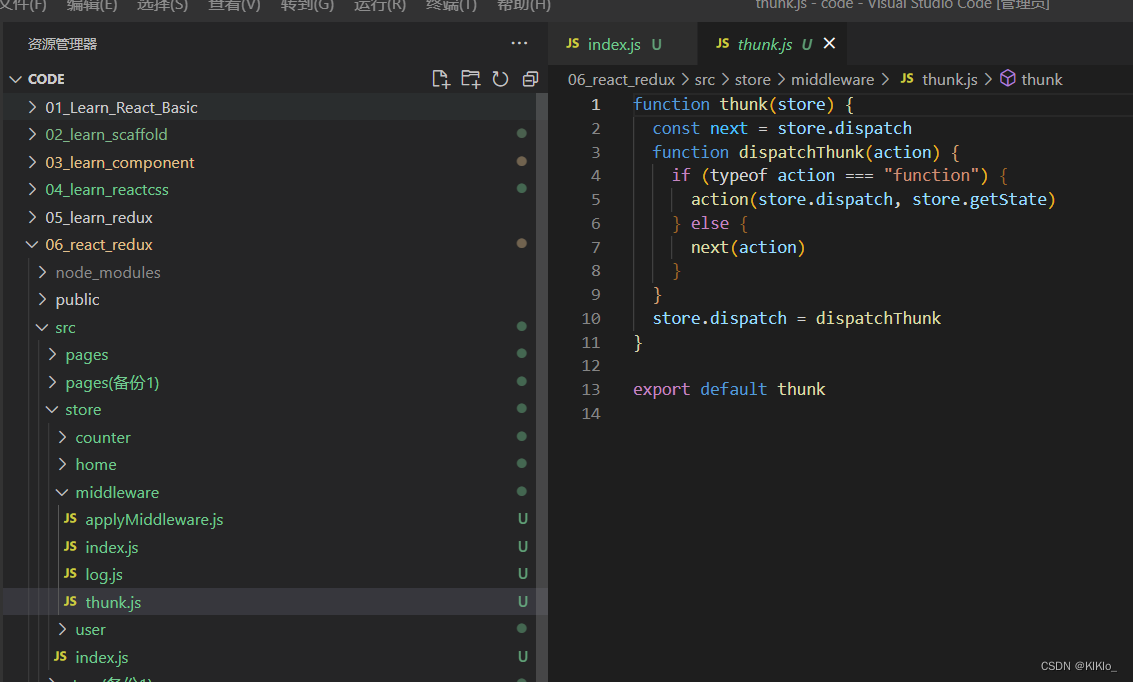

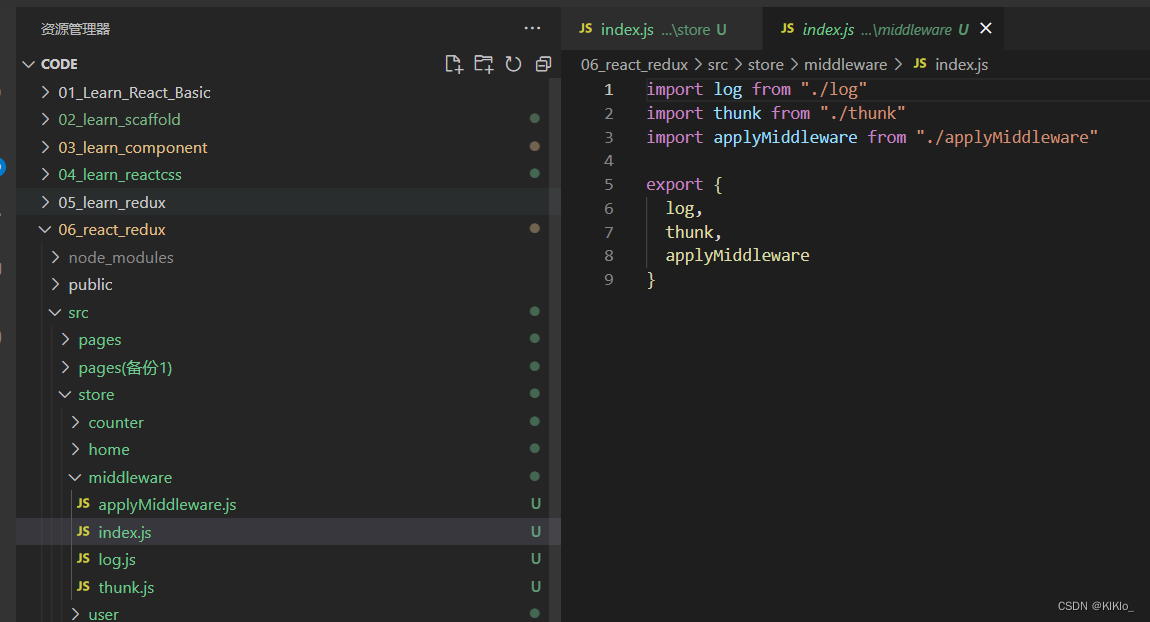

8、React中的state如何管理
